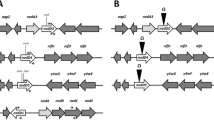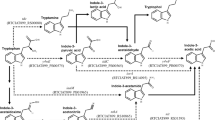Abstract
Purine pathway in Rhizobium is important during the nodulation processes. The purL gene in Sinorhizobium fredii (S. fredii) has been identified to be required for the whole establishment of a nitrogen-fixing nodule. To get a better understanding of the purL gene’s impacts on Rhizobium–plant interaction, the competitive nodulation abilities of S. fredii containing different purL expression plasmids were studied. Several kinds of coinoculations were performed, including using different bacterial concentration ratios, with or without the supplementation of purine source in the plant nutrient solution, and the delayed coinoculation tests. The results indicated that the competitive nodule occupancy of S. fredii was affected significantly by the purL expression level during the early nodulation periods. The mutant strain containing no purL expression could not elicit competitive nodules both in the presence and absence of purine source. A positive linear correlation within certain limits was observed between strain’s competitive nodule occupancy and purL gene expression level. All these results suggested that the purL gene played a role in the competitive nodulation of S. fredii.


Similar content being viewed by others
References
Beringer JE (1974) R factor transfer in Rhizobium leguminosarum. J Gen Microbiol 84:188–198
Bittinger MA, Milner JL, Saville BJ, Handelsman J (1997) rosR, a determinant of nodulation competitiveness in Rhizobium etli. Mol Plant Microbe Interact 10:180–186
Buendia-Claveria AM, Moussaid A, Ollero FJ et al (2003) A purL mutant of Sinorhizobium fredii HH103 is symbiotically defective and altered in its lipopolysaccharide. Microbiology 149:1807–1818
Djordjevic SP, Ridge RW, Chen HC, Redmond JW, Batley M, Rolfe BG (1988) Induction of pathogenic-like responses in the legume Macroptilium atropurpureum by a transposon-induced mutant of the fast-growing, broad-host-range Rhizobium strain NGR234. J Bacteriol 170:1848–1857
Dowling DN, Broughton WJ (1986) Competition for nodulation of legumes. Annu Rev Microbiol 40:131–157
Giraud E, Moulin L, Vallenet D et al (2007) Legumes symbioses: absence of Nod genes in photosynthetic bradyrhizobia. Science 316:1307–1312
Lopez-Garcia SL, Vazquez TE, Favelukes G, Lodeiro AR (2002) Rhizobial position as a main determinant in the problem of competition for nodulation in soybean. Environ Microbiol 4:216–224
Newman JD, Diebold RJ, Schultz BW, Noel KD (1994) Infection of soybean and pea nodules by Rhizobium spp. purine auxotrophs in the presence of 5-aminoimidazole-4-carboxamide riboside. J Bacteriol 176:3286–3294
Newman JD, Schultz BW, Noel KD (1992) Dissection of nodule development by supplementation of Rhizobium leguminosarum biovar phaseoli purine auxotrophs with 4-Aminoimidazole-5-Carboxamide Riboside. Plant Physiol 99:401–408
Oka-Kira E, Kawaguchi M (2006) Long-distance signaling to control root nodule number. Curr Opin Plant Biol 9:496–502
Okazaki S, Hattori Y, Saeki K (2007) The Mesorhizobium loti purB gene is involved in infection thread formation and nodule development in Lotus japonicus. J Bacteriol 189:8347–8352
Triplett EW, Sadowsky MJ (1992) Genetics of competition for nodulation of legumes. Annu Rev Microbiol 46:399–428
Worland S, Guerreiro N, Yip L, Djordjevic MA, Weinman JJ, Djordjevic SP, Rolfe BG (1999) Rhizobium purine auxotrophs, perturbed in nodulation, have multiple changes in protein synthesis. Aust J Plant Physiol 26:511–519
**e B, Chen DS, Zhou K, **e YQ, Li YG, Hu GY, Zhou JC (2006) Symbiotic abilities of Sinorhizobium fredii with modified expression of purL. Appl Microbiol Biotechnol 71:505–514
Zhang Z, Chen H, Li F, Fan Y (1991) Construction of gene library and isolation of pRaZ15 containing complete nodulation genes in Rhizobium astragali. Chin J Biotechnol 7:213–219
Acknowledgments
This work was supported by the project 30270052 and 30800021 of National Natural Science Foundation of China, the project 001CB108901 of Chinese Key-Fundamental Research Program and the project ICA4-CT-2001-10056 of EC-RTD Program.
Author information
Authors and Affiliations
Corresponding authors
Rights and permissions
About this article
Cite this article
**e, B., Chen, D., Cheng, G. et al. Effects of the purL Gene Expression Level on the Competitive Nodulation Ability of Sinorhizobium fredii . Curr Microbiol 59, 193–198 (2009). https://doi.org/10.1007/s00284-009-9420-0
Received:
Revised:
Accepted:
Published:
Issue Date:
DOI: https://doi.org/10.1007/s00284-009-9420-0




